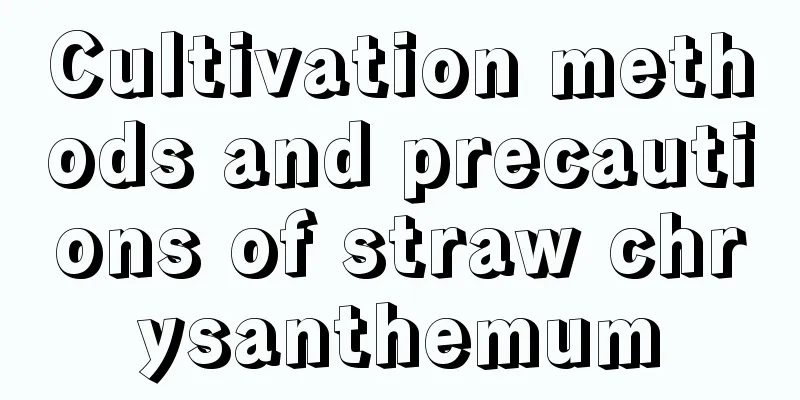Cultivation methods and precautions of straw chrysanthemum

1. Maintenance methods1. Temperature: It is neither cold-resistant nor heat-resistant. The suitable temperature for its growth is around 20 degrees. If the temperature exceeds 25 degrees in summer, it needs to be cooled down. If the temperature is below 5 degrees in winter, it needs to be kept warm. 2. Watering: Spring and autumn are its vigorous growth periods, and it needs to be watered every three days. The temperature is higher in summer and the water evaporates faster, so it needs to be watered every three days. If the water used for watering is tap water, it needs to be dried before use. In winter, you need to control the amount of watering and watering once a week is enough. 3. Fertilization: During the growth period, fertilizer is needed once every half a month. Nitrogen, phosphorus and potassium compound fertilizer should be used, because compound fertilizer has comprehensive nutrition and can meet the needs of the plant in all aspects. Stop fertilizing during the dormant period to avoid fertilizer damage. 4. Light: It cannot accept strong light exposure. Under strong light, its branches and leaves will quickly become dehydrated and the leaves will become dull. During the growing period, six hours of diffuse light per day is sufficient, and four hours of light per day is sufficient during the dormant period. 2. Breeding techniques1. Reproduction: The sowing method is generally used to propagate straw daisy. The collected seeds are sprinkled into the soil with sufficient nutrients and moist soil, and then covered with a thin layer of soil. The moisture of the soil is kept at 50%. It is placed in a warm and dark environment for maintenance. The seedlings will emerge in about a week. After germination, they cannot be transplanted for the time being. You should wait until it grows three true leaves before transplanting. This way the survival rate will be higher. 2. Pruning: When it is in its vigorous growth period, the branches on the top of the plant can be removed in order to concentrate nutrients and promote the growth of side buds. If you find tender buds on the top of the plant, you can also remove them together to prevent the plant from growing too tall. 3. Problem Diagnosis1. Pests: It is more susceptible to pests such as paulownia tortoise shell. When the insects are still in the larval stage, it is necessary to spray some pesticides once or twice a week. 2. Pathology: Catalpa trees are susceptible to carbuncle in humid climates. When the disease occurs, the leaves will fall off, so ventilation needs to be increased during maintenance. If the plants are infected with anthracnose, they can be sprayed with carbendazim. IV. Other issues1. Toxicity: It is non-toxic. Not only is the bark non-toxic but it can also be used, and the leaves have a detoxifying effect. 2. Is it suitable for indoor cultivation: If the potted plants have been treated, they can be cultivated indoors. If it has not been processed, it is not recommended to grow it indoors, because it grows too fast and the plant is too large, which does not meet the conditions for home cultivation. |
<<: Tomato cultivation methods and precautions
>>: Cultivation methods and precautions of Emerald Philodendron
Recommend
Does Chlorophytum comosum prefer shade or sun?
Does Chlorophytum comosum prefer shade or sun? Th...
Is Arisaema poisonous?
Medicinal value Arisaema has high medicinal value...
Field Management Technology of American Ginseng
American ginseng is a traditional Chinese medicin...
When does camellia bloom? Which city's flower is camellia?
1. What season does it bloom? Camellias bloom in ...
When does yellow rose bloom?
Flowering period of yellow rose Rosa rugosa is an...
How long does it take for bamboo begonia cuttings to take root?
Rooting time of cuttings of Begonia When cutting ...
How many times can wheat be planted in a year and when are the planting periods?
How many crops can wheat be planted in a year? Wh...
Can Paulownia flowers be eaten?
Are Paulownia flowers poisonous? Paulownia flower...
How to water Tangyin
Tangyin Spring and Autumn Watering Cycle Spring a...
The causes and treatments of yellow leaves of Aspidistra
1. Too much light Reason: It is afraid of direct ...
How to prune daisies
How to prune daisies Daisies can be pruned in spr...
What to do if the anthurium flower withers
1. Water appropriately Improper watering will cau...
How many years does it take for green plums to bear fruit?
Growth habits of greengage trees The green plum t...
Is it better to use a large or small pot for the bird's nest?
1. Flowerpot size Under normal circumstances, a n...
How to grow lilies
1. Soil To grow lilies, you need to use fertile s...









